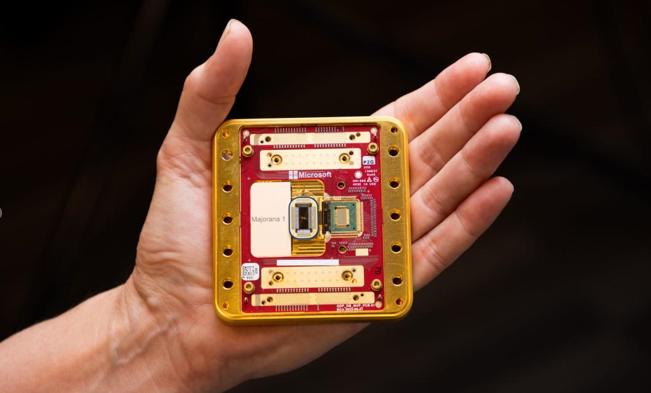
In 2025, Microsoft announced the release of the $1 billion topology quantum chip "Majorana 1", but this milestone breakthrough has been embroiled in intense scientific controversy. This game surrounding the existence of Majorana particles not only exposes the deep contradiction between the "law of scale" and the "black box problem" of quantum computing, but also reflects the eternal tension between technological fanaticism and academic rigor in scientific exploration.
The 2020 Science paper claimed that the preparation of Majorana particles in nanowires is considered a key breakthrough in constructing anti-interference quantum bits. However, after the subsequent correction statement clarified some terms and expanded the data, the independent expert still questioned the authenticity of the experimental signal. Professor Simon from Oxford University pointed out that similar research had been withdrawn by Nature due to unreliable data, and although Microsoft's "Majorana 1" chip released in 2025 uses indium arsenide wafers instead of nanowires and claims to achieve 8 topological quantum bits, Professor Oppenheim from University College London emphasized that "there is no conclusive evidence to prove that its quantum bits are based on Majorana particles." The focus of controversy is that material disorder may produce the same electrical conductivity signal as Majorana, and Microsoft's "false signal modeling" scheme has not been widely recognized by the academic community.
The "law of scale" of quantum computing requires an exponential increase in the number of qubits to achieve computational advantage, but the technological path of topological qubits has fallen into a "black box dilemma". The Microsoft team claims to reduce error rates by a thousand times through the use of "four-dimensional topological quantum error correction codes," but Professor Legg from the University of St. Andrews pointed out that "there is even no evidence of fundamental physical effects in the device." This contradiction is essentially the concretization of the "black box" characteristics of quantum mechanics - as Academician Guo Guangcan of the Chinese Academy of Sciences said, the interpretation of quantum phenomena is still like a "blind man touching an elephant," with multiple versions such as the Copenhagen interpretation and navigation wave theory coexisting but each having its own flaws. The EU's Artificial Intelligence Act requires high-risk AI systems to provide decision interpretation, which mirrors the "interpretability" of GPT-5 neural networks: when quantum computing pursues a scale of millions of qubits, the explanatory power of its underlying physical mechanisms may actually degrade.
The controversy reflects deep-seated issues in the scientific research ecosystem. The "quantum gamble" that Microsoft has invested heavily in has been criticized by Jay Sau of the University of Maryland as an "excessive frenzy intertwined with science, social media, and business," while the 2023 Copenhagen University investigation did not find academic misconduct, but the controversy over data filtering continues to ferment. This serves as a warning to us: in the pursuit of technological breakthroughs, we need to be wary of the erosion of scientific rigor by the "results oriented" approach. The EU law's requirement for interpretability of AI systems provides a mirror for quantum computing - a true technological revolution requires the establishment of a transparent and verifiable scientific foundation, rather than relying on "black box" myths.
I believe that the future of quantum computing should not be a 'either or' choice. Enterprises need to actively embrace "transparent governance": by storing experimental data on blockchain and establishing an independent third-party verification mechanism, such as Microsoft's ability to publicly disclose raw conductivity data for cross validation by academia. Policy makers need to promote a "dynamic compliance" framework that allows technology to be prioritized but mandates subsequent verification, such as the "risk grading regulation" in the EU's Artificial Intelligence Act, which can be applied to the quantum field. More importantly, the international scientific community should establish a "dispute resolution community" and eliminate methodological differences through cross-border joint experiments, such as the lunar mantle research model jointly developed by China National Nuclear Corporation and Peking University. Only by finding a dynamic balance between innovation and rigor can quantum computing truly break through the "black box" dilemma and achieve a steady leap from the laboratory to the industry.
This controversy will eventually be written into the history of quantum computing. It reminds us that true scientific progress is never a one-sided victory, but an eternal cycle of doubt and verification. When the data privacy of 400 million ChatGPT users becomes a bargaining chip in the judicial game, the "black box" of quantum computing also needs to be illuminated - not to deny possibilities, but to remain clear headed in fanaticism and approach truth in controversy.

Due to the continuous decrease in rainfall and the rapid drop in groundwater levels, several large sinkholes have successively appeared in several agricultural areas in central Turkey in recent years, causing great concern among local farmers and environmental experts.
Due to the continuous decrease in rainfall and the rapid dr…
The Prime Minister's Office of Israel said Hamas attacked I…
Fourteen countries including the United Kingdom, France and…
The US Department of Justice said on Wednesday (December 24…
The Japanese government has submitted a draft, planning to …
On December 25th local time, NVIDIA announced a technology …